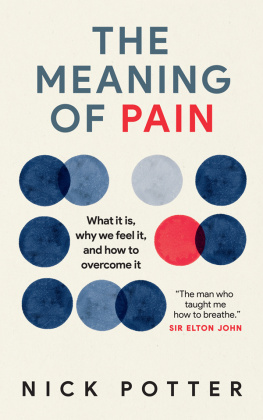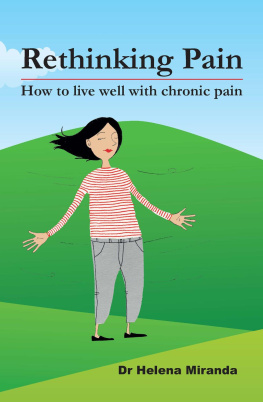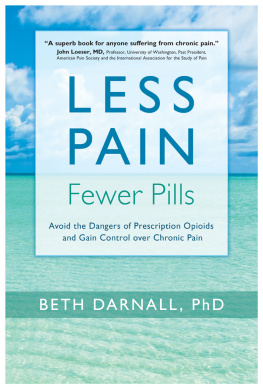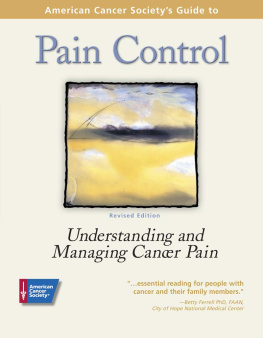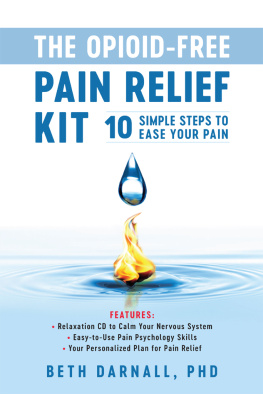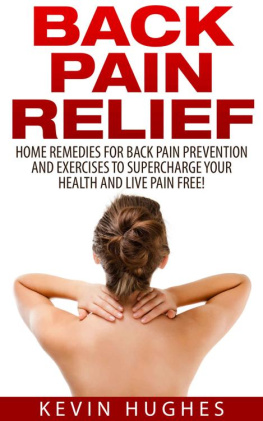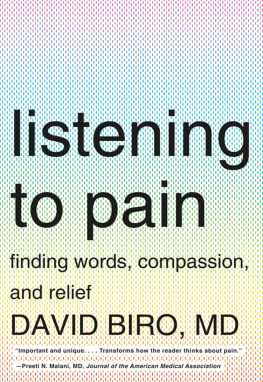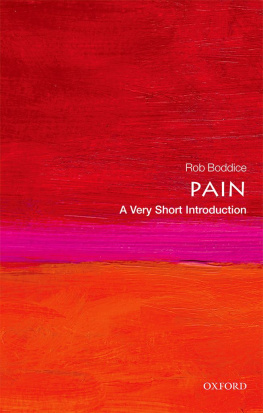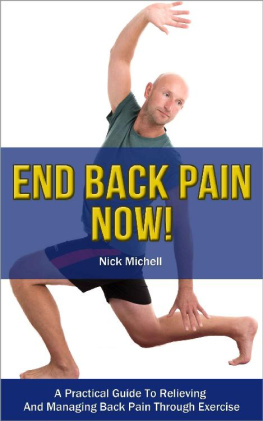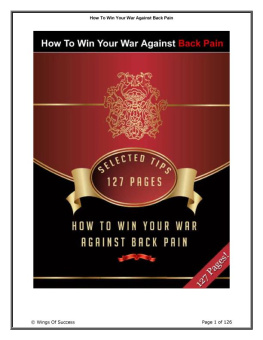

The content of this book is intended to inform, entertain and provoke your thinking. This is not intended as medical advice. Neither the author nor the publisher can be held responsible or liable for any loss or claim arising from the use, or misuse, of the content of this book.
To my amazing wife Bex and my two wonderful children
Emi and Jack.
It is not to see something first, but to establish solid connections between the previously known and the hitherto unknown, that constitutes the essence of scientific discovery. It is this process of tying together which can best promote true understanding and real progress.
Hans Selye, The Stress of Life
CONTENTS
With his easy, flowing prose, Nick makes the science of pain understandable, dispels the myths and emphasises always the importance of attending to the equilibrium of the individual, by recognising and dealing with stress in all its forms This book is written from the heart by someone who is truly passionate about his subject and cares tremendously for his patients.
Dr Sean White FRCA FIPP FFPMRCA
Nick Potter is an exceptional osteopath, and has an extraordinary ability to instantly know what I have been doing wrong physically to cause me pain and then alleviate it. I am certain that if I followed all his advice and did all the exercises he wants me to do I would never be in pain again. Unfortunately I am too lazy, which is why Im booked in again with him next Thursday at 2pm!
Michael McIntyre
Pain whether chronic or transient is an insidious threat to mental well-being and emotional stability. In this excellent, well informed and optimistic book, Nick Potter applies his extensive expertise to helping readers understand the experience of suffering from pain, and shows them that there is a surprising amount they can do on their own to address and manage it. It is a pleasure to read.
Professor Robert Bor, Consultant Clinical & Aviation Psychologist, Royal Free Hospital
Thoughtful and provocative... Nick Potter is a brilliant osteopath and diagnostician.
Gail Rebuck
INTRODUCTION
It is far more important to understand what person the
disease has than what disease the person has.
Hippocrates
I always like to know why someone decides to write a book what drives them to do it and whether they have skin in the game either professionally or through personal experience. When it comes to pain, I think I have both.
Professionally, I am a consultant osteopath, and during 27 years of clinical practice, hundreds of patients have entrusted their problems and bodies to me. I now run a clinic at the Princess Grace Hospital in London, and before that spent 17 years at the London Spine Clinic, where I specialised in conditions of the cervical spine, the area around the neck. I became known there as Nick the neck, and was very proud of my results in reducing neck surgery by 80 per cent.
After completing my degree in osteopathic medicine in London, I soon realised that, although university had given me a wonderful training and I had had some inspirational teachers, it wasnt quite enough. So I went on to do more training, and worked in the US, France, Australia and Germany. Exposed to a wide variety of medical and non-medical approaches in different cultural settings, I gradually built my toolbox of skills.
For the past two decades, my life has been split between my hospital clinic and the world we call performance science, or performance medicine, which focuses on the optimisation of performance, especially in sports. In the late 1990s when the Chelsea Harbour Club opened in London, a team of us set up a sports medicine clinic called Total Health, where we took a multidisciplinary approach to health and fitness which was quite revolutionary for its time. From there I went in 1999 to join the Institut Biomdical Sports et Vie (IBSV), set up by Dr Franois Duforez, who was doctor to the Formula One driver Alain Prost. Based in Paris, the IBSV (later renamed vielife) carried out driver assessments to improve performance, and as part of this we quickly realised the importance of data and building trends in the less obvious arenas of sleep, stress, global travel, nutrition, light exposure, mindset and so on. What we did not have at the time was Bluetooth and wireless technology to monitor these trends more regularly and accurately that would prove to be a game changer. But, even without these digital aids, we soon saw that what we were learning about the treatment of elite sportsmen, particularly with regard to stress, could have a much wider application not least in the corporate world. We started to formulate a special set of assessments for people operating in a high-stress executive environment under the notion of the corporate athlete. And this being the frenetic early 2000s before long CEOs and board-level executives who were suffering with issues similar to those that affected elite athletes started coming to us for help. Like top athletes, people at executive level in high-stress companies can easily become isolated from their colleagues and have to bury the stress that they feel in case it shows weakness. This takes its toll and manifests in their physiology, which we had learned to measure. The two most commonly complained of issues were sleep and musculoskeletal pain. Ultimately, both were caused by stress. I am still using this application today in particular, in recent years, working for a leading hedge fund, where I look at the impact of stress on traders and how to manage it.
That early experience of working in performance medicine which also included stints with the Jordanian, Jaguar and McLaren Formula One teams, as well as in elite golf, tennis and athletics gave me a number of things. It indulged my obsession with people-watching as it involved really working out what made humans tick. And it showed me that each and every athlete was different and therefore a general training programme would never suffice. I realise now that we were way ahead of our time and I was phenomenally lucky to work with such ground-breaking experts. It has also been hugely influential in the way I work in a clinical setting.
When I first started in clinical practice, osteopathy was seen by some as very alternative and complementary, even shrouded in charlatanism and quackery. Indeed, GPs could be disciplined for referring a patient to one. Oh, how things have changed! Over the years I have seen its principles embraced by the medical community and have helped in some small way in pioneering its scientific art in a traditional and very medical environment. Many of the new imaging and investigatory techniques that have been developed over the last few years have not only supported but indeed proved the principles and efficacy of the osteopathic philosophy and its techniques.
Having said that, I feel very strongly that, in a bid to become recognised by the orthodox community, we as a profession should not lose any of the philosophy that has set us apart from, and given us the edge on, modern drug-and surgery-based medicine. In recent years, I have seen a pendulum-like swing in modern medicines approach. It has gone from a technology-driven profession of keyhole surgery and clever drugs to one that is now increasingly wary of interventions of any kind, due to the realisation that many of them, with hindsight, do not work or are, in terms of healing, no better than time. To a large extent, the old interventionist model was born from the need to reduce costs in our health system and to find what was efficient in the short term rather than what really worked. It was driven by a consumer-type demand from patients to be cured and the recognition by drug and surgical companies that there was an exciting demand out there to be satisfied. But what they were missing was that the human body relies on systems that do not work in isolation but are intricately linked in a web of myriad connections, within a unique and conscious being. Nowhere is that truer than in the field of pain.
Next page
